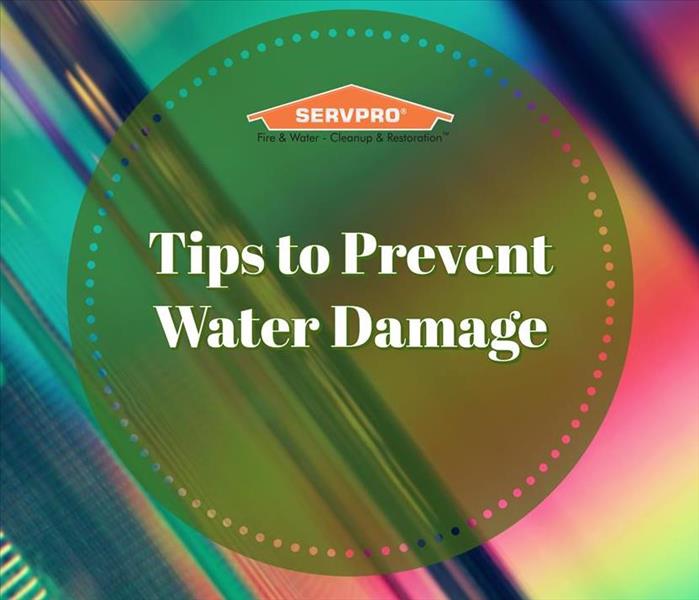Recent Water Damage Posts
24 Hour Emergency Water Damage Service
3/29/2024 (Permalink)
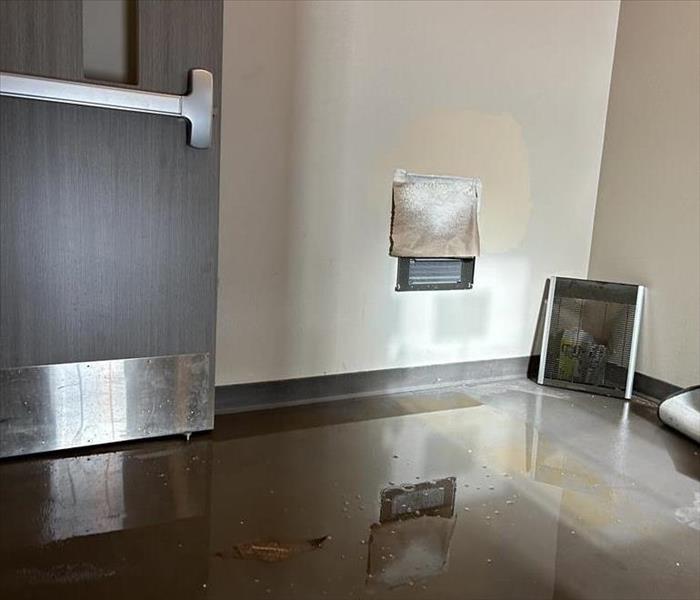 This flood was caused by a broken water pipe in an apartment complex
This flood was caused by a broken water pipe in an apartment complex
SERVPRO of Bismarck is available 24 hours a day for water emergencies, large or small. When you are dealing with water damage, immediate action is crucial. A delay of just a few hours can greatly increase the severity of the water damage.
We Answer the Phone Ready to Help
Call Today - 701-852-7378
We understand that when you call us, you may be feeling confused, stressed, and vulnerable. You need an expert to guide you through this crisis. SERVPRO of [[Franchise Name]] has the specific water damage training and experience to help you through this tough time. We specialize in water damage restoration—in fact, it's the cornerstone of our business.
What to Expect
When you call, we will ask several questions regarding your water damage emergency. These questions will help us determine what equipment and resources to bring, including how many trained SERVPRO professionals may be needed.
Our SERVPRO Representative will ask several questions:
- Your name and contact information
- Your insurance information (if applicable)
- The street address of the water-damaged home or business
- When did the flooding or water damage occur?
- What caused the water damage (if known)?
- Is there electricity available (on-site)?
About SERVPRO of Bismarck
SERVPRO of Minot specializes in the cleanup and restoration of residential and commercial property after a fire, smoke or water damage event. Our staff is highly trained in property damage restoration. From initial and ongoing training at SERVPRO’s corporate training facility to regular IICRC-industry certification, rest assured our staff is equipped with the knowledge to restore your property.
How to Prepare for a Winter Storm
1/4/2023 (Permalink)
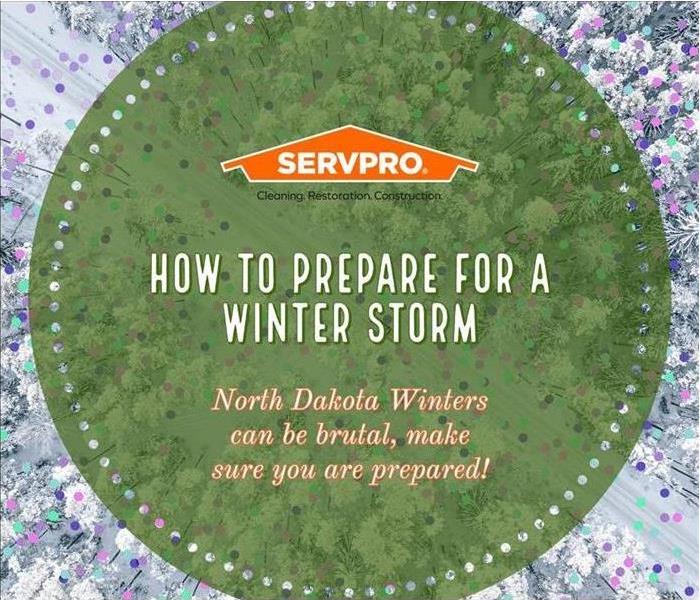 Preparing for Winter Storm
Preparing for Winter Storm
In North Dakota, we are no strangers to a bad winter. With freezing temperatures, lots of snow, and high winds, winter storms can be dangerous for your home and your family. Here are some tips to make sure you’re ready for the North Dakota winter.
Be prepared to lose power.
The biggest worry during a storm is that you will lose power. Although this is usually restored within a few hours, it is very possible to lose power for multiple days if there are multiple power lines down throughout the area. Stocking up on non-perishable food, warm clothing, and buying batteries is essential. If you can have a generator fueled and ready to power your home, this would be the best-case scenario to ensure your families safety. Be in contact with friends and family and have an emergency home to go to in case you need to stay a few days somewhere else while power is restored.
Be aware of frozen pipes.
In freezing temperatures, water pipes are very susceptible to freezing. Even if your home has power and heat, pipes can still freeze. To prevent this, use water sources regularly so that water flows through pipes and doesn’t have time to build up and freeze. If you try to use a sink, toilet, or appliance and there is no water coming into it, this is a sign you might have a pipe break. Another tip for prevention, is to have a tiny drip of water flow through your pipes to stop pressure from building up.
Remove snow as far away from home as possible.
If feasible, push snow away from your home. This will prevent ice from building up around your home and its foundation, which could cause cracks and leaks inside the house. Pushing snow away from your home will also help during spring when snow and ice begins melting, if there is too much water near your home, it can seep in through the foundation or other cracks in your windows or siding. Although sometimes snow has to be piled up next to your house, when possible, push it as far away as possible.
We hope you and your family stay safe this winter! If you ever suspect you have water damage, give us a call and we can use our water detection technology to find any leak or pipe break!
When Does Water Damage Cause Mold?
8/29/2022 (Permalink)
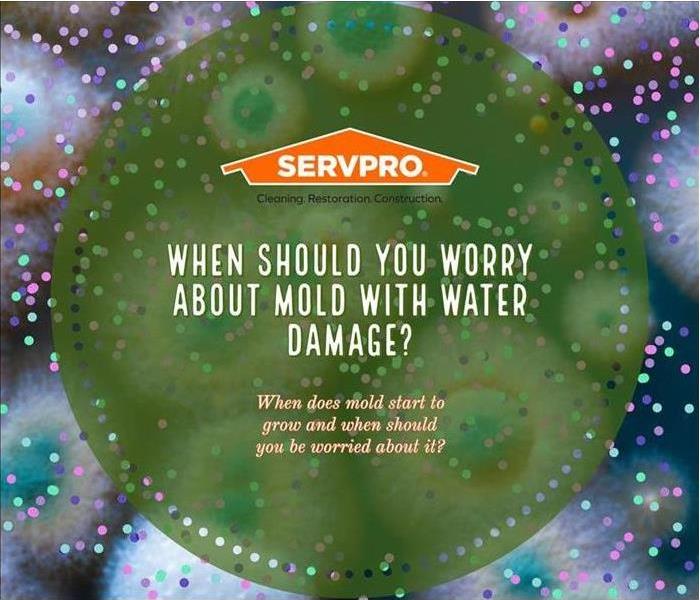 Mold growth is a nasty business!
Mold growth is a nasty business!
Whenever you have a water loss, it is a nerve-racking experience. You have to worry about cleaning up the water, drying out what's affected, and possible mold growth. Sometimes you can take care of these things on your own, other times a professional company, like SERVPRO®, needs to come in and assess and then clean it. With any water loss, mold should be a worry, but when does water actually cause mold growth?
Different types of water damage that can cause mold growth are:
- Sewage back-up from flooding in the area
- Plumbing or roof leaks
- Damp basement or crawl space
- Overflows from sinks for bathtub
- High humidity: steam cooking, dryer vents, humidifiers
- Any type of stagnant water in your home
Mold will begin to grow 24-48 hours after the initial water damage. If you discover the source of damage, stop it quickly, and clean up the mess, you likely don't have to worry about mold. If the water damage isn't found within a few days, mold is going to become a concern.
If the water is not dried out within that time window, a professional may apply antimicrobial products to prevent growth. This is why you should contact a professional no later than 48 hours after the initial damage if there is still moisture present.
The best way to prevent mold growth from water damage is to clean up the water and dry out the area as fast as possible. If you aren't sure whether or not you can dry it out on your own, contact SERVPRO of Bismarck and we can advise you on the next steps to take to prevent further damage to your home.
Tips for Cleaning Up Water Damage in Your Home
8/29/2022 (Permalink)
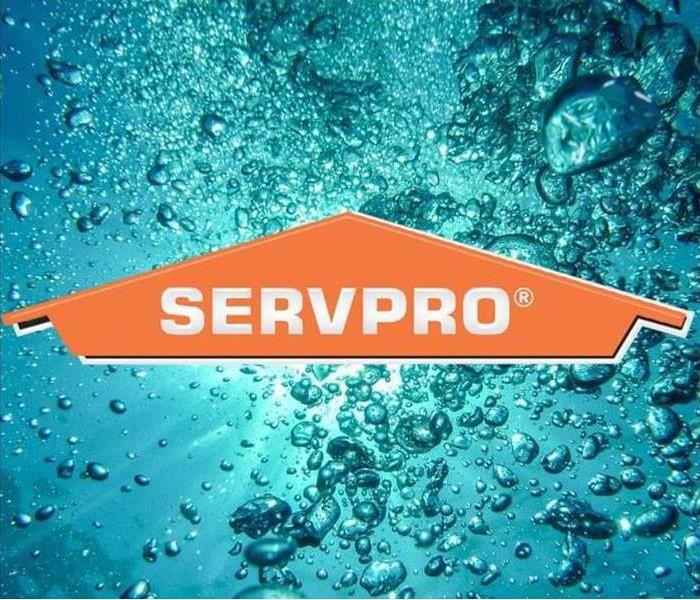 SERVPRO of Bismarck is "here to help".
SERVPRO of Bismarck is "here to help".
It can happen in an instant: A pipe bursts, flooding your home. It's a nightmare scenario for homeowners and renters alike, but it's not all doom and gloom. With the right knowledge and preparation, you may be able to save some of your belongings from water damage. Here are five tips on cleaning up water damage in your home:
Do not enter affected areas if electrical outlets, switches, circuit breakers and electrical equipment are exposed to water. Always avoid electrical shock hazard.
Once you're sure the electrical power has been turned off, do not enter areas where you can see or suspect water damage to wiring and equipment. Water may be hiding behind walls and in other places that are hard to see, so always assume there is a risk of electrical shock when working in such conditions.
Shocking yourself on an exposed wire could lead to a heart attack or even death. Call a professional who knows how to restore lost power safely.
Don't try using a wet vacuum cleaner because it can cause electrocution and burn out the motor on your machine. If you own a shop vac (which is not recommended) make sure that it's unplugged before attempting use if possible since there's less chance for electrocution that way, but don't rely on this method exclusively since most shop vac have motors with very little insulation between them that still could cause problems if submerged in water for long periods of time - especially salt water which conducts electricity much easier then fresh!
Do not use your household vacuum cleaner to remove water; this could cause electrical shock or damage to the vacuum cleaner.
If your home has been affected by floodwaters, do not use your household vacuum cleaner to remove water; this could cause electrical shock or damage to the vacuum cleaner. Instead, use a wet/dry vac. Remove water from the affected area as quickly as possible and then call in a professional.
Do not turn on ceiling fixtures if ceiling is wet, and keep out of rooms where ceilings are sagging from retained water.
If you have any ceiling fixtures in your home, don't turn them on if the ceilings are still wet. You could cause a short circuit and cause yourself more damage. If it has been a few hours or longer, you can safely turn on ceiling lights without causing any harm to yourself or your home.
If you see that one side of the ceiling is sagging due to retained water from the flood, stay out of that room until it's fixed.
Avoid contaminated objects, including soaked furniture and debris. Cover your nose and mouth with a cold cloth or dust mask when entering an area with a strong odor of gas or chemicals.
- Don't enter the area if electrical outlets, switches, circuit breakers or electrical equipment are exposed to water
- Don't use your household vacuum to remove water
- Don't turn on ceiling fixtures if ceiling is wet
- Don't enter areas where ceilings are sagging
Water damage can occur in your home at any time, but knowing what you should do can save you valuable time and money!
Water damage is one of the most common reasons for a home inspection. Many homes are built on stone foundations and have basements that are below ground level, meaning water can enter through cracks in the foundation or where pipes enter the basement ceiling/floor. Water leaks from plumbing fixtures such as toilets and faucets can also cause problems if left unattended for too long.
The best thing to when it comes to water damage is prevention. That means checking regularly to make sure all drains are clear of debris or hair clogs which may prevent them from draining properly, keeping your gutters clean so they catch falling rainwater and directing it away from your foundation before it has a chance to seep into cracks or leaky windowsills around doors leading outside (if left unchecked this type of problem could lead not only into other rooms but also outdoors. Ensuring all windowsills aren't cracked before replacing them with new ones so no more moisture get trapped inside after being exposed directly under bright sunlight all day long (this will help keep mold growth under control).
If you have any questions, please feel free to contact us at any time! SERVPRO of Bismarck is always happy to help out our customers with their home projects!
Water Damage Safety Tips After a Storm
8/29/2022 (Permalink)
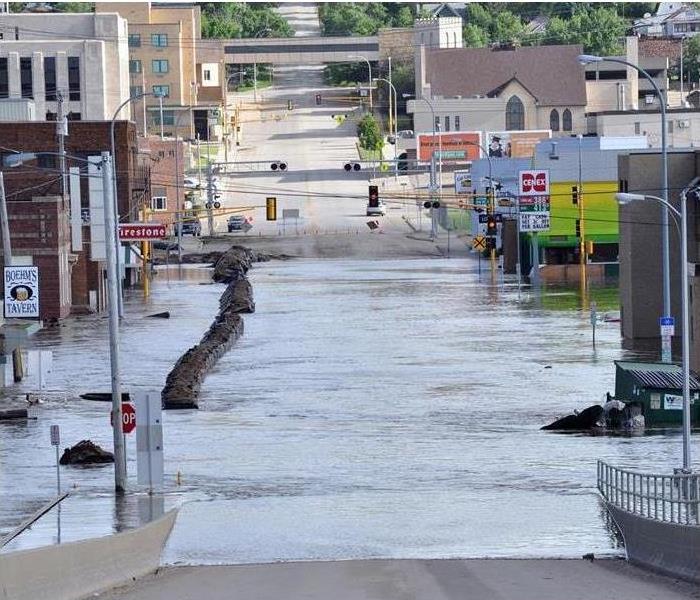 Souris River flood of 2011
Souris River flood of 2011
Heavy rain fall from massive summer storms can easily cause flooding outside and inside your home. After any water damage situation, you primary focus should be safety first. Here are some safety tips to follow until help arrives:
- Is it safe to stay inside the house?
- Electrical sand "slip and fall" hazards are some of the prevalent concerns.
- Only do activities that are safe for you to preform.
- Wet materials can be very heavy. Be careful!
What to Do After Flooding
- Remove excess water by mopping and blotting.
- Wipe excess water from wood furniture after removal of lamps and tabletop items.
- Remove and prop up wet upholstery and cushions
- Place aluminum foil or wood blocks between furniture legs and wet carpeting.
- Turn air conditioning on for maximum drying during the summer months.
- Remove colored rugs from wet carpeting.
- Remove art objects to a safe, dry place.
- Gather loose items from floors.
What NOT to Do After Flooding
- Don't leave wet fabrics in place. Hang furs and leather goods.
- Don't leave books, magazines, or other colored items on wet carpet or floors.
- Don't use your household vacuum cleaner to remove water.
- Don't use the television or other household appliances.
- Don't turn on ceiling fixtures if the ceiling is wet, and keep out of rooms where the ceilings are sagging.
For any water damage caused by a storm, call SERVPRO of Bismarck to help you clean up the mess and make it feel "Like it never even happened".
Our Six-Step Drying Process
8/26/2022 (Permalink)
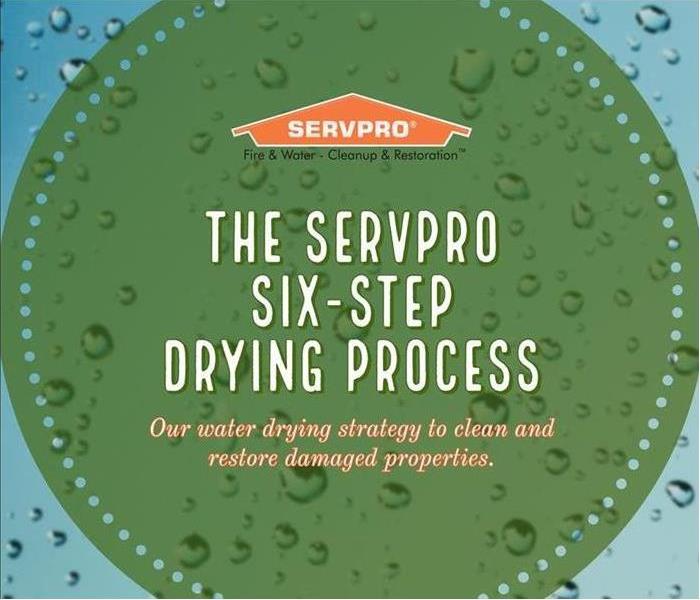 Check our thorough 6-step drying process
Check our thorough 6-step drying process
When North Dakotans are confronted with water damage, SERVPRO is the most trusted cleaning and restoration company in the state. This is due, in part, to our Six-Step Recovery Process used to ensure a property is completely dried and restored after suffering from water damage. Whether it is from broken pipes, sewer backups, or appliance leaks, we use the same process to ensure quality results.
Step 1. Emergency Contact
The first step is when we get the call. Whether it is directly directly from the property owner or from an insurance professional, we get all of the details needed to begin our response. This includes detail about the loss, contact and address information, and what has been affected by the damage. This gives our team the best idea of what equipment and specially trained technicians to send to begin response.
Step 2. Inspection and Damage Assessment
Once the call has been received, an inspection will be scheduled and SERVPRO technicians will be sent to assess the damage and begin work if approved by the property owner and their insurance. In most cases, a property owners insurance policy will cover initial services to mitigate damage, such as water extraction and removal. This means that our technicians can begin work immediately without needing to get an estimate approved by the insurance provider.
Step 3. Water Removal/Water Extraction
The water process begins with packing out any materials to prevent further damage. This could be furniture or boxed items, or anything that can be moved to help our technicians best begin water removal.
Once items have been removed, powerful pumps and truck-mounted extraction wands are used to remove any existing water. This powerful suction technology will remove most of the moisture from affected flooring, making the drying process go quicker and smoother.
Step 4. Drying and Dehumidification
Once the excess water has been removed, the floors and walls may appear dry, but a quick inspection will reveal that they are wet to the touch. Nearly all building materials, like wood, drywall, and flooring materials, and porous and therefore retain water. This retained water can cause the materials to break down, warp, or cause mold damage.
Using commercial grade dehumidifiers and high- volume air removers, we begin drying out the area while monitoring the progress with handheld moisture meters. For most jobs, the drying process will be complete in 1-3 days, depending on the size and amount of moisture in the materials. After drying is complete, the final repairs can be scheduled and made.
Step 5. Cleaning and Repair
After drying is finished, cleaning and repair takes place. This varies from job to job but could involve cleaning off affected contents such as clothes, furniture, or other belongings. Additionally, for water damage, the area is cleaned and sanitized with special anti-microbial agents to prevent mold growth. Also, deodorizing might take place if there is a smell left over from the damage.
When stopping water damage, this can mean cutting into walls to stop further damage or to remove wet materials. After the area has been dried out, any leftover debris is removed and documented for the restoration repairs.
Step 6. Restoration
The final step is our recovery process in the restoration. While we try to save as much of the existing property as possible, oftentimes some things are unsalvageable. In these cases, our Build-Back department works with your insurance provider to restore the property to the condition it was in prior to the loss.
This can be as simple as replacing damaged carpet, or as extensive as a complete tear down and reconstruction of the damaged area. Whether it is a complete bathroom restoration, or a simple wall replacement, we work with the insurance provider every step of the way to get approvals based on existing policies to get a seamless restoration completed.
What Causes a Sewer Back Up?
8/26/2022 (Permalink)
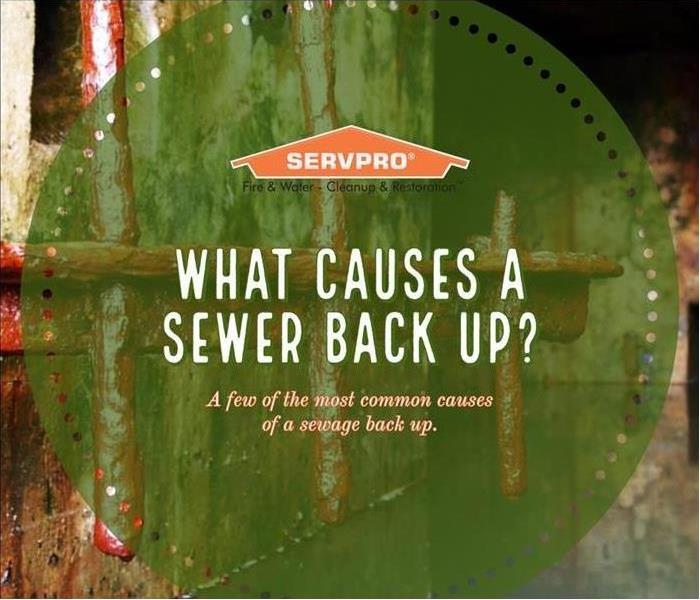 Sewer backups are nasty things to deal with!
Sewer backups are nasty things to deal with!
One of the common homeowner insurance claims are sewer backups. This ends up being a nasty, messy catastrophe in your home, but what is the cause of it? There are multitude of reasons why you could experience a sewage backup, but here are a couple of the most common.
Clogged Drains
Clogged drains are one of the most common reasons for a sewer backup. Improper use of toilets and sinks can cause a main sewer line to become clogged. Flushing cleaning wipes, diapers, napkins, and many other hygiene items can cause a sewer line to become clogged over time. Sewer lines are filled with a volatile combination of hair, soap, and dirty water. Adding things such as grease or excess kitchen waste can clog the drain and lead to a sewer backup.
Tree Roots
Sewer lines often run under front lawns and nearby tree roots can grow into and around the pipes. Trees have expansive root systems and even if the pipe itself is not near a tree, the roots can spread out and around the pipe.
Once a tree root has grown into a sewer line, the line will need to be replaced and often times the tree roots removed or trimmed down. This will be a big project involving digging into the ground and replacing the existing sewer lines.
Which Appliances are Most Likely to Leak
8/26/2022 (Permalink)
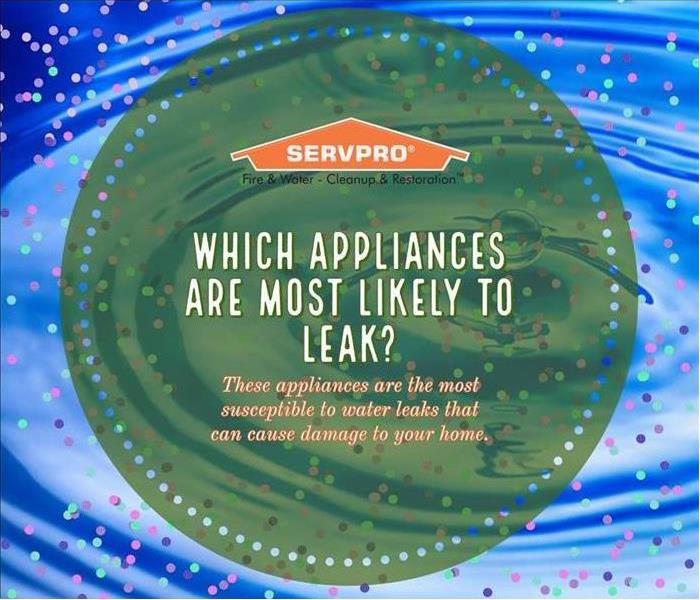 Watch your appliances for leaks
Watch your appliances for leaks
Although any appliance that uses water is susceptible to a leak, here are the ones you need to be most aware of to prevent a wet disaster in our home.
Hot Water Heater
Most water heaters will last 10-15 years, but leaks can happen at any time. The seals going into the water heater can break down quickly because of the constant pressure from heating and cooling. With hot water heaters also being tucked away into closets, leaks can go unnoticed until they become a major problem.
Dishwasher
A dishwasher's water lines are typically make from a soft plastic that can easily fail, so checking for leaks under the dishwasher as part of your annual home maintenance is wise. If you notice dishes not being clean, strange noises, or your dishwasher just not working right, inspect for a leak.
Washing Machine
Washing machine hoses are some of the most common sources or leaks. Because they are notorious for this, it is recommended that they are inspected at least once a month by homeowners so you can be sure no issues have arisen. In addition to these regular checks, they should be fully replaced every five years in order to prevent hidden deterioration.
Air Conditioner
The drain in your HVAC unit is designed to keep condensation from pooling in and around the unit. But if this drain malfunctions, water damage can quickly be caused. Reference you manufacturer's manual to determine how often your unit should be inspected and serviced. Having a professional technician evaluate your machine is the best defense against HVAC-created water damage.
While not as likely to create as big of a mess, window air conditioners can also create leaks from condensation buildup, pump failures, and a number of parts issues. Most of the time these leaks can be cleaned up with towels and the unit repaired, but improper use over a period of time can create a leak and cause a mold problem as well.
What to Do if You Discover Water Damage in Your Home
8/26/2022 (Permalink)
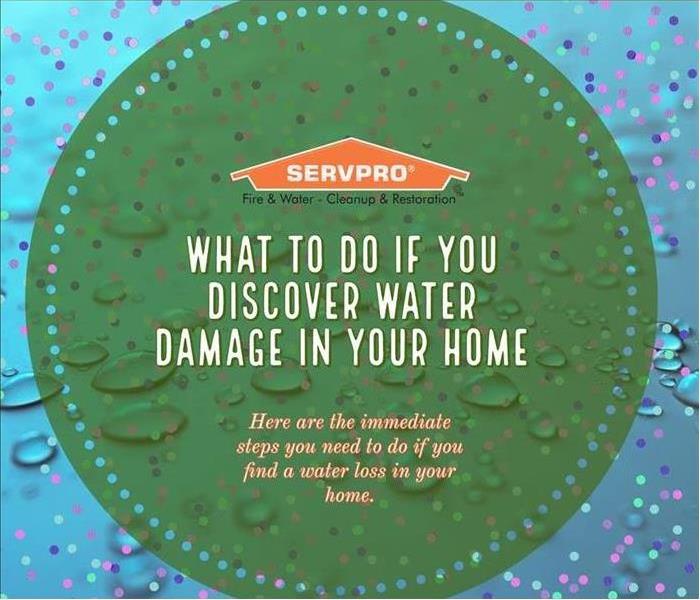 Here is what to do if your basement floods, roof leaks, or sewer backs up!
Here is what to do if your basement floods, roof leaks, or sewer backs up!
Water damage comes in many forms. When you first discover it you can be in a panic and not know what to do. Here are the first steps you should take if you discover a large water damage incident in your home.
Turn Off the Water
It doesn't matter how quickly you can clean up the existing water if you do not stop more from coming in. Find and close your home's main water valve. Also turn off any circuit breakers to that area to prevent an electrical shock.
Call Your Insurance Provider
Get in touch with your home insurance company and let them know you have had a water damage incident. They will open a claim and will schedule an adjuster to come assess the damage.
Call SERVPRO of Bismarck
After you get the claim number from insurance, contact us so we can immediately send a technician to begin the mitigation process. With water damage, the sooner the excess water is removed and drying, the cheaper and quicker the process will be. Once you give us your insurance information, we can work with that provider to begin work.
Clean Out Any Items That Could be Affected
If water is in an area, it will continue to spread out and absorb into materials. Place furniture on wood blocks and remove boxes, clothes, or other items in the immediate area that could be damaged by water. Preventing further damage will save everyone time and money. If the water is contaminated by either sewer or wastewater, anything that is touches will need to be cleaned or replaced.
Discovering a water loss in your home can be scary. Just follow these steps and you will be on your way to making it "Like it never even happened".
What Needs Replacing After Water Damage?
8/26/2022 (Permalink)
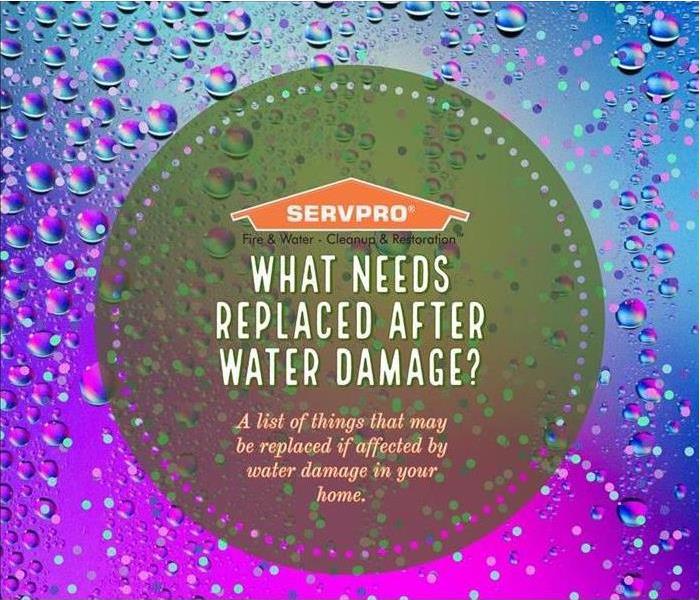 More things might need replacing than you think!
More things might need replacing than you think!
Water damage can happen unexpectedly. Anything from a dishwasher hose break, a sump pump failing, or a toilet backing up can lead to hundreds or thousands of dollars in damage. This cost is what it takes to remove the water, dry out the affected area, remediate any potential mold growth, remove unsalvageable materials, and replace those materials. This is why a full coverage insurance policy is a must-have for homeowners, covering the cost for the work to get your property back to a preloss condition. Here are some items that you might need to replace if you have a water loss in your home.
An important note is that anything touched or effected by dirty water such as sewer or that contaminated by waste, needs to be replaced or thoroughly cleaned and disinfected. Other items that may need replacing are:
- Water can seep into the wall and soak up into the insulation behind it. To prevent further damage, we create 3 foot flood cuts on any affected walls. This means removing the bottom 3 feet of wall and removing wet materials.
- Like walls, removing and replacing flooring affected by water damage is necessary, (if the floor can't be dried out properly).
- Children's toys
- Dog toys
- Furniture
- Trim/baseboard
- Cabinets
While we never think of water damage happening in our home, it is important to be prepared for it. Check your insurance policy, maintain your home, and if you ever have water damage in your home, call SERVPRO of Bismarck as soon as possible to get the water damaged cleaned up quick!
What is a Sump Pump?
8/25/2022 (Permalink)
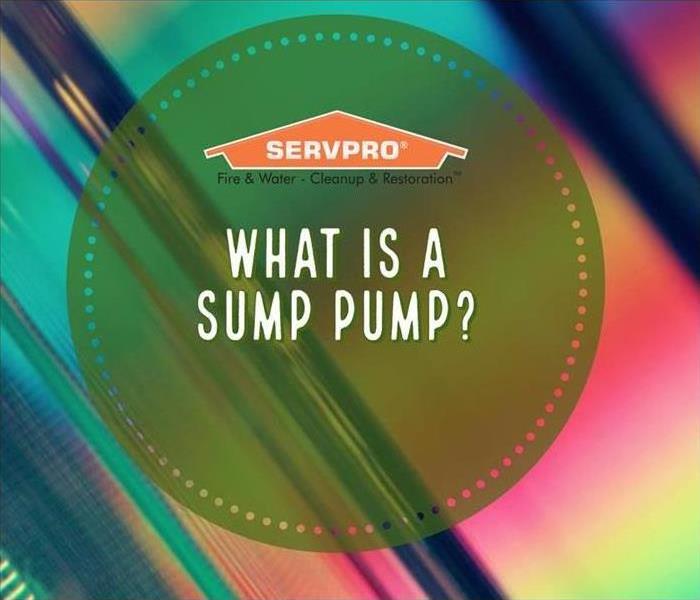 Your Home's Best Defense Against Water Damage!
Your Home's Best Defense Against Water Damage!
You will almost never think about your sump pump, unless it's broken, and that is the way it should be. A sump pump has one purpose and that is to make sure you never think about it because it is doing its job perfectly of keeping your home safe and dry. But what, exactly, is a sump pump?
Below your basement is a catch basin that is designed to accumulate water from around your home so that it does not seep inside the foundation, which is known as a sump. When the water accumulation begins to fill the sump, a pump is used to move the water out of the basin and into a storm drain. This pump, the sump pump, keeps water out of your basement, leaving it dry.
There are different types of sump pumps. Some are automatic, while others need to be manually operated. There are also submersible sump pumps, pedestal, battery operated, water-powered, and a variety of others. The type of sump pump you have depends on your budget, preferences, and the environment around your home.
A sump pump is your home's best defense against water damage. While it can't prevent damage from broken pipes, leaks in the roof, or appliance malfunctions, a sump pump can prevent water around your home from causing any problems. Without a sump pump, your basement could have a constant influx of moisture which would cause weak floors and walls, odors and mold growth. A worst case scenario would be completely flooded basement because there was nothing pumping the water out.
Keeping your sump pump in working condition is crucial, having a broken sump pump is better than not having one at all. Typically, a sump pump is good for 5-10 years and will either need replacing or repairs afterwards. Hopefully, once you set it in place, you won't have to think about until after those 5-10 years, which is when it is time for replacement.
How do you know when to replace a sump pump? If it is making unusually loud noises, this could be due to several factors, including debris jams, worn out parts, or constant use. If you are concerned about your sump pumps condition, test it by dumping water around the pump and see if it starts automatically and drains the water quickly. If it appears to be operating incorrectly, contact a service provider to replace it. You don't want to wait to do this as you never know when a heavy rainfall could occur.
Secure Your Home Before Your Summer Vacation
8/25/2022 (Permalink)
 Keep your home safe this summer!
Keep your home safe this summer!
As we make our way through the summer months, you may be going on a trip or two. If so, here are some simple ways to make sure you come back to your home safe and sound, and not a watery nightmare.
Do an Inspection
As you're packing the car and getting ready to head out, do a quick inspection of your home to ensure you are ready to leave. Turn off the water main, and drain the existing water from the sinks, toilets and outdoor spigots. Once the water main is switched off, turn on faucets, spigots and flush toilets under water no longer flows out.
Other places to inspect:
- Pipes under every sink
- Water heater
- Seals around windows (in case it rains)
- Appliance hoses: washing machine, dishwasher, and ice maker
- Sump pump - dump a bucket of water into the sump pump to make sure it's working. Make sure to listen to its motor running as well.
- Toilet tanks - look for cracks that may worsen and leak while you're gone
Have Someone Check Your Home
Give a set of keys to a trusted family member, friend, or neighbor and have them check on your home periodically while you're gone. The amount of times they should check in depends on the length of your trip, but should at least be twice a week. Once water damage occurs, letting it stagnate for days at a time can multiply the cleanup cost tremendously. Show your house sitter all bathrooms, where the water main is, and other areas that are at risk of water damage. Leaving a check list for them will make sure they don't miss any subtle leaks or moisture.
Leave heating and cooling running as normal. These allow air flow through your home and prevent humidity from building up. They also will keep pipes from freezing if there is a sudden temperature drop one night, which is more of risk during the fall and winter months than in summer.
Enjoy Your Trip!
If you do a thorough inspection, take proactive safety measures and leave someone to look after your home, then you have done more than enough to ensure you won't suffer from water damage. Although anything is possible, and even the most cautious plan can still not prevent water damage, you shouldn't worry about the safety of your home while on vacation. Take steps to prepare and enjoy your time away!
What to Do if You Have Frozen Pipes
8/25/2022 (Permalink)
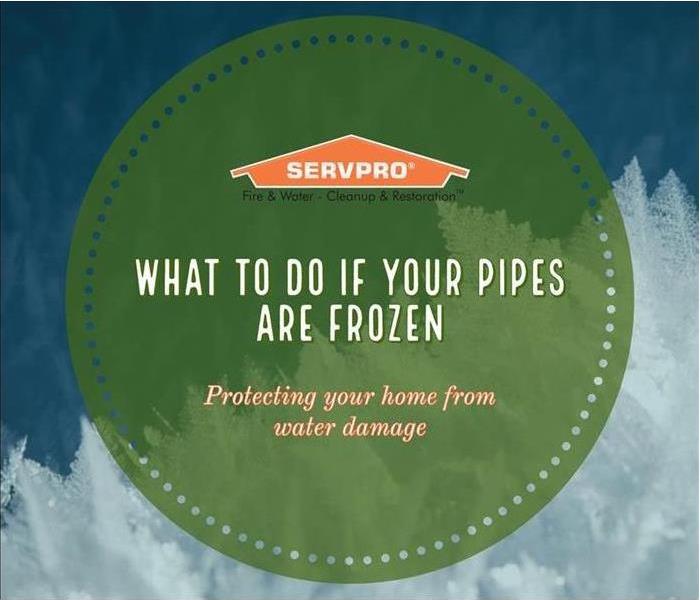 Watch out for frozen pipes this winter!
Watch out for frozen pipes this winter!
This is the time of year where harsh North Dakota winters pose the biggest threat of frozen pipes to your home. When water freezes in your home's pipes, the water molecules expand into an ice blockage preventing water from passing through. This creates a pressure buildup in the pipe which can lead to a burst a wet mess throughout your home or business. With North Dakota's long stretches in negative degree temperatures, your home's water pipes can quickly freeze if not taken care of. Here are some ways to know if your pipes are frozen and some remedies for how to fix them if you discover one is frozen.
Most of the time, a frozen pipe is not obvious. This can cause a problem as you will not even know it is frozen until it is too late. Signs of a frozen pipe include:
- No running water or even a trickle: In these cases, the pipe leading to the tap may be broken.
- Frosted over pipes: If you can see frost on a visible pipe, there's a good chance that it's frozen. Of course, this is more difficult to check on pipes that are not in visible areas.
- Odd smells: If a pipe is blocked because of ice, you or your tenants may notice an unpleasant smell coming from the tap or drains.
If you suspect a pipe is frozen, you should immediately shut off your main water line to prevent further water from flowing into the pipe. Next, you should attempt to slowly thaw out the pipe, if possible. DO NOT use open flames to thaw it out. Try using other heat sources such as a hairdryer or towels soaked in hot water or increasing the temperature of the room by bringing in warm air.
If you suspect your pipes are at risk of bursting, immediately call a plumber and have extra towels ready to soak up a spill. Additionally, find a water mitigation company (such as SERVPRO of Bismarck) and be ready to call them to cleanup any mess that may occur if the pipe bursts. The sooner a technician can arrive, the more damage can be prevented.
While frozen pipes can be a dangerous situation, if discovered soon enough, you can take steps to protect your home and avoid a costly cleanup charge.
The Effects of a Sump Pump Failure on a Finished Basement
8/24/2022 (Permalink)
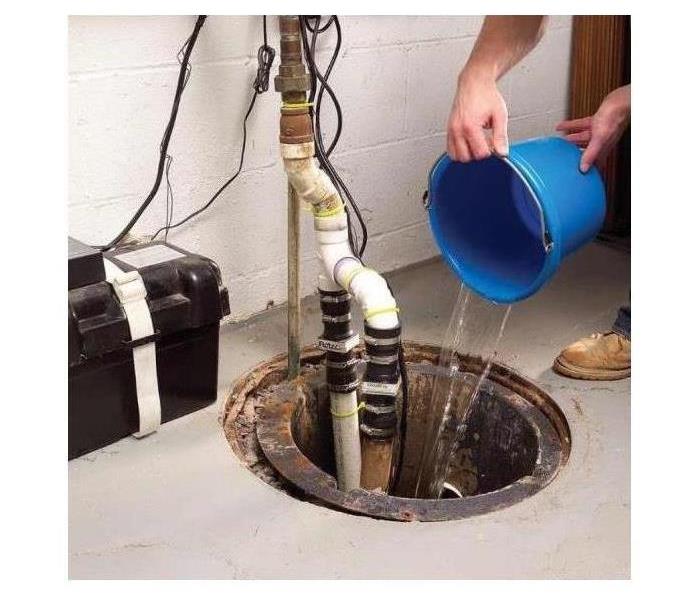 Check you sump pump regularly!
Check you sump pump regularly!
Sump pumps have an average lifespan of 3 to 5 years, which means of you own a home with a sump pump you can anticipate it failing at some point. Sump pumps are used to prevent water from outside seeping into your house, which is particularly common during heavy rainfall. It is important to ensure your sump pump is operating correctly.
To test your sump pump, fill a five-gallon bucket with water and pour it slowly around the sump pump. The pump should kick on once the water level reaches a predetermined level below the basement floor. If the pump doesn't turn on, it may be either clogged or damaged.
When sump pumps fail, water comes into your house that can be significantly contaminated. SERVPRO of Bismarck's technicians are trained to evaluate your home's building materials to determine which materials can be saved, and which must be removed.
Building materials that are not salvageable that are not removed can support microbial growth. Salvageable materials that are exposed to the water for too long can also be destroyed.
If you have any questions, call SERVPRO of Bismarck for your water emergency. With our trained professionals and specialized equipment, we will make it "Like it never even happened".
Tips to Prevent Water Damage
8/24/2022 (Permalink)
One of the great things about living in the modern world is access to usable water. In much of the 3rd world, having water for drinking, cleaning, and plumbing is not possible. With this wonderful access, we have to be careful. If not monitored carefully, the damage can be catastrophic and expensive. Here are some SERVPRO safety tips for preventing water damage.
Most water damage claims do not come from storms, floods, or heavy rainfall, but rather from neglect in monitoring and replacing minor parts. An easy way to prevent damage is to replace and upgrade hosing, pipes, and other small parts that can easily break.
Make sure all of the drains are working properly. If a sink or bathtub isn't draining properly, it could lead to future problems. Ways to keep your drains in good condition are:
- Avoid pouring grease down the drain.
- Keeps drains clean with a regular cleaning schedule.
- Always keep a strainer in place on the sink and shower/tub drains.
- Frequently clean out the strainer and deposit the debris in the trash, not back down the drain or in the toilet.
Prevent ice dams from forming. In the cold North Dakota winter, and ice dam forms when warm air from the attic melts the snow on the roof which freezes in the cold air. If left unchecked, the ice can build up and push into cracks between the walls and roof leading to leaks which can cause water damage throughout your home. Prevention of this includes:
- Having your gutters and downspouts cleaned, inspected, and repaired during the fall to ensure clear passage of water.
- Insulate your attic properly - heat in the home should not reach the attic. Warm air can melt the snow on the roof which refreezes and forms ice dams. Make sure the attic floor is airtight by sealing any openings.
- Providing enough ventilation to the attic to keep the roof cool. Warm air should escape through vents near the top of the attic. Cold air should flow through vents near the eaves. The temperature in the attic should be 5 to 10 degrees warmer than the outside temperature.
- Remove the snow on your roof when it's about 6 inches deep. Use a roof rake or a long-handled brush to remove the snow without a ladder.
The best way to prevent water damage is to maintain and upkeep the quality of your home. These small, and affordable home projects can prevent large, expensive calls down the road.
3 Tips to Prevent Spring Water Damage
8/24/2022 (Permalink)
Even as the snow continues to accumulate, it is important to remember that we will soon be in the spring months. With the warm weather on the way, (hopefully), it is important to remember that with all the snow melting, all the water left in its place can cause problems if you aren't prepared. Here are three quick tips for protecting yourself from any damage that the melting snow could bring:
- Make sure your sump pump is working at 100%. Inspecting it for any built up ice, dirt, or other debris and clearing that out now will prevent failure in the future. Once you have cleared it of any debris, turn it off an on, making sure it starts afterward to ensure it is operating at full capacity.
- A easy way to prevent loss of valuable items is to do some spring cleaning. By going into your basement and cleaning out any unnecessary items that have been stored over the winter and moving valuable ones to safe areas, you can prevent those items from being destroyed in the event of a flooded basement. While cleaning your basement, you can inspect for cracks in the foundation or any other weak spots at risk for letting in water.
- The North Dakota snow is brutal, and while it is hard enough to clear driveways, sideways, and walking paths, it is important to clear as much around your house as possible. Once the snow melts, it can pool underground next to your house and seep in through cracks causing thousands of dollars in damage. By using a snow blower, skid steer, or even just shoveling it away, creating a 3-5 foot perimeter around your house will prevent a large loss of time and money in the future.
As the warm spring weather approaches, it is important to take steps now to make sure you are not at risk of having unnecessary damage to your home.
Why Your Water Bill is So High
8/24/2022 (Permalink)
How much water does your home use? Every month you might take a look at your water bill and think, "We went through THAT much water?" From the sink, to the dishwasher, toilet, washing machine, drinking water, and gardening hose, you might be shocked at how much water you go through. After a while, your water bill will begin to set into a pattern, and you will know your usual consumption. However, if one month it is an oddly high bill, these could be the causes.
The biggest concern with a high water bill is that there is an unknown leak in your house. Toilets are the first place that should be checked. Toilets are in a continuous state of flushing and can go through almost 200 gallons of water a day! If you hear a toilet running, this is an obvious sign, but by looking into the tank you can often find the source of the problem. Once you have inspected all of the toilets, look at sinks or faucets for leaks to see if they have loose handles, pipes, or cracks that could be dripping water out. Next, check appliances that use water such as refrigerators, freezers, and hot water heaters. The connectors may be loose or have worn down over time and this may be the source of the leak. If you do not find a leak at any of these spots, then maybe there is no leak and it could be one of the other causes for a high water bill.
You may have forgotten about large sources of water use. Water use is not fixed and fluctuates throughout the year. During the summer, you could be using a garden sprinkler or filling up a pool or have more people staying with you, such as kids home for summer break. During the winter, you may have family staying for the holidays or if your heating system is powered through the use of hot water. As the seasons change, so does the use of our water. Make sure to account for this when you look at your bill.
If neither of these seem to be the cause of your high water bill, then it might be time to look at the way you are measuring your consumption. Water meters are used to measure the amount of water you use each year. While there are ways to read this on your property, it is usually done remotely by the water authority. You can request to have your meter checked for accuracy to confirm your previous bill. While uncommon, it is always smart to confirm your bill is accurate.
If you are still not sure the cause of your high water bill, you may have an underground leak. This can be a costly problem to solve and will likely require either bringing in an expert or purchasing detection equipment. There will often be an underground hissing sound that will give away the leak. If you have checked all of the above possibilities for finding the cause of your high water bill. It may be worth considering an underground leak. If you believe this is the case, you should contact a professional inspector to look for the cause and confirm if this is true.
Monitoring your monthly water bill is the best way to make sure you don't have further problems in the future due to water damage. A tiny leak, if left unchecked, can cause thousands of dollars in water damage, sewage, and mold, and you will be left on the hook for the water bill as well. Make sure to monitor your monthly water bill closely and watch for any unknown peaks.
Water Damage Response Tips
8/24/2022 (Permalink)
You are going to panic initially when you realize your home has suffered water damage. Once you give us a call, we can quickly send technicians out to begin remediation on damaged property. Before we arrive, instead of panicking, you can take steps yourself to prevent further water damage. These steps should only be used if the damage is caused by clean water. If you have suffered damage from sewage, toilet, or other contaminated water sources, stay away from the scene as it may have adverse health effects.
Here are tips for what you can do to prevent further water damage to your home until our trained technicians can make it to you:
- Shut off the water source if it can be done safely.
- Remove any excess water by mopping or using towels.
- Remove and prop up upholstery cushions for drying. Do not put cushion covers in washing machine.
- Place aluminum foil or wood blocks under furniture legs.
- Hang furs and leather goods separately at room temperature.
- Remove colored rugs from wet carpeting.
- Do not use a regular vacuum to try and remove excess water.
- If water damage is in the ceiling, do not turn on lights or overhead fans. Keep out of rooms where the ceiling is beginning to sag from holding water.
Leaky Pipes
8/22/2022 (Permalink)
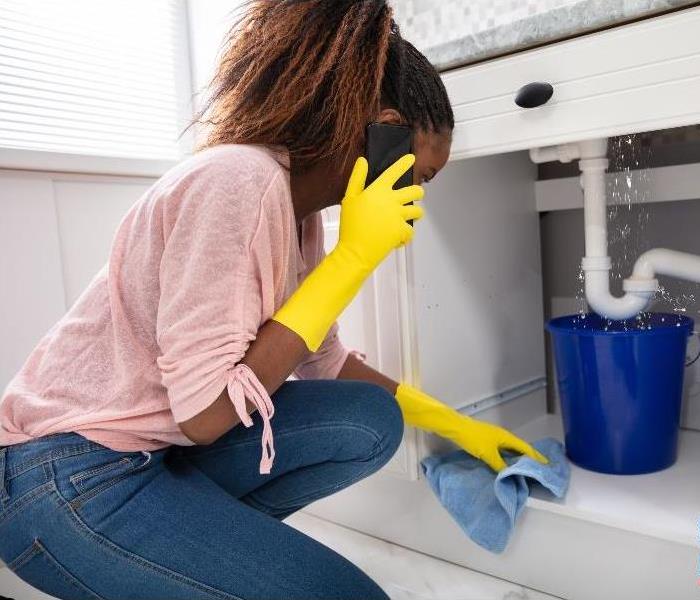 Don't let your pipes look like this!
Don't let your pipes look like this!
A simple drip under the sink doesn't seem like a big issue at the moment. Put a bucket underneath the leaky pipe and the problem is solved, right? Wrong. Think of the simple drip like a very small crack in the Hoover Dam. Say it's patched, but it still leaks. It's patched again and again and the cycle continues, the small fixes, like the bucket, until that crack becomes too big and the dam breaks, causing unimaginable damage to everything the dam was protecting. Still not worried about that little leak under your kitchen sink yet? Hoover Dam vs. your kitchen. The math doesn't add up. But getting the pipe fixed does, and having SERVPRO of Bismarck inspect the area for any water damage or possible mold!
It's important to keep up with the small issues before they become big ones!




 24/7 Emergency Service
24/7 Emergency Service













